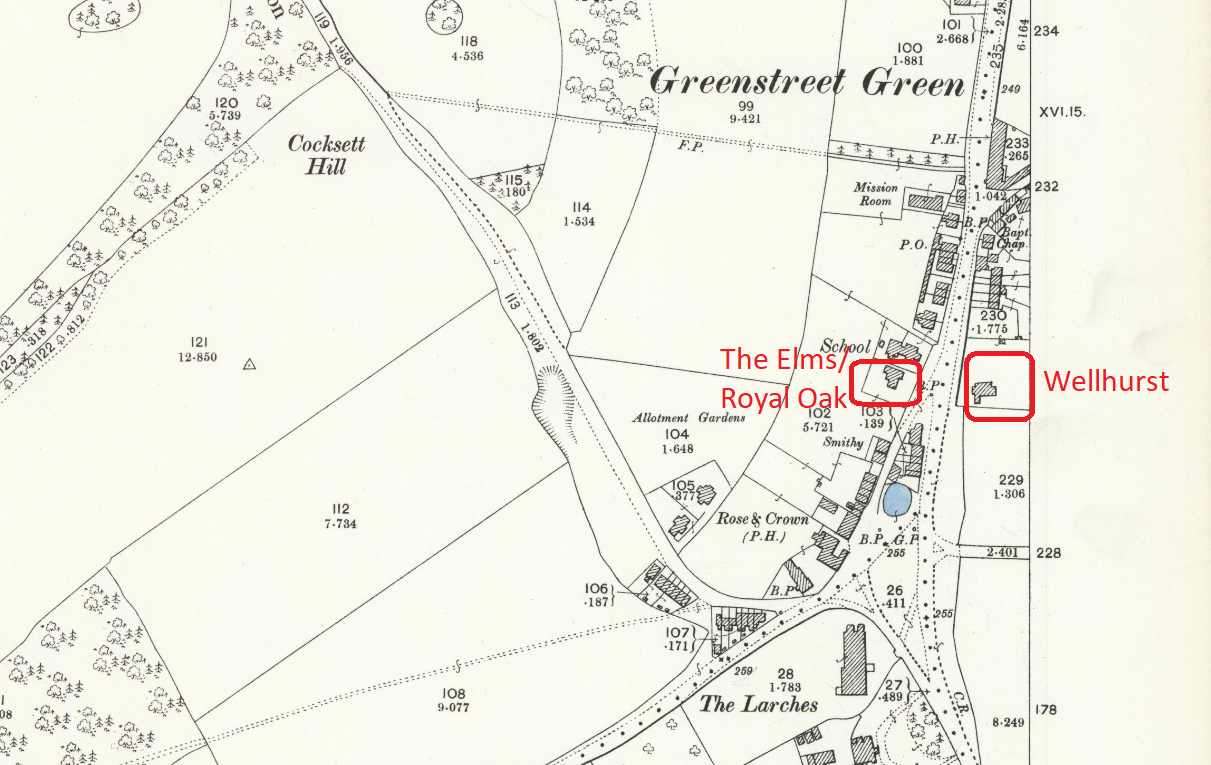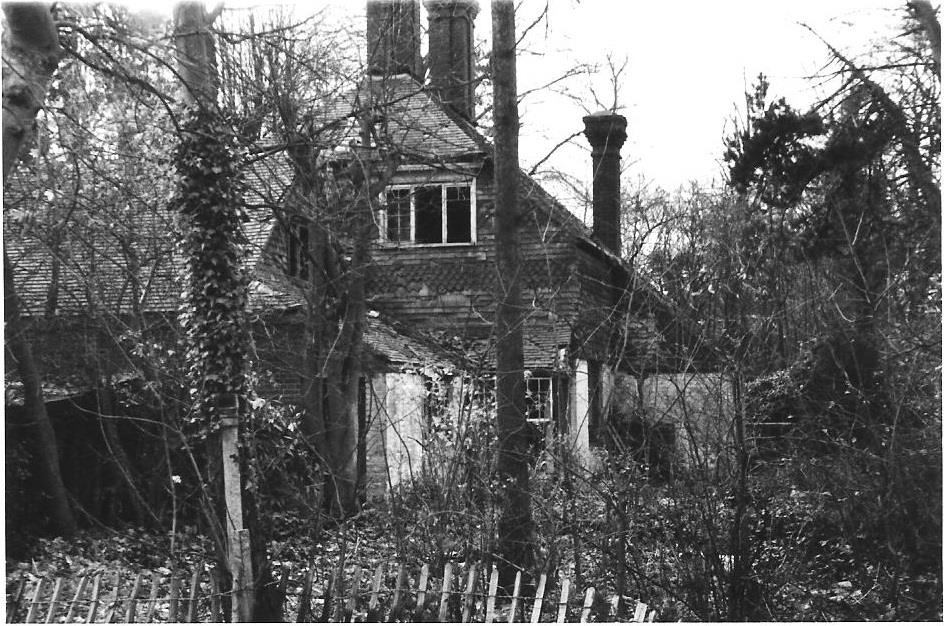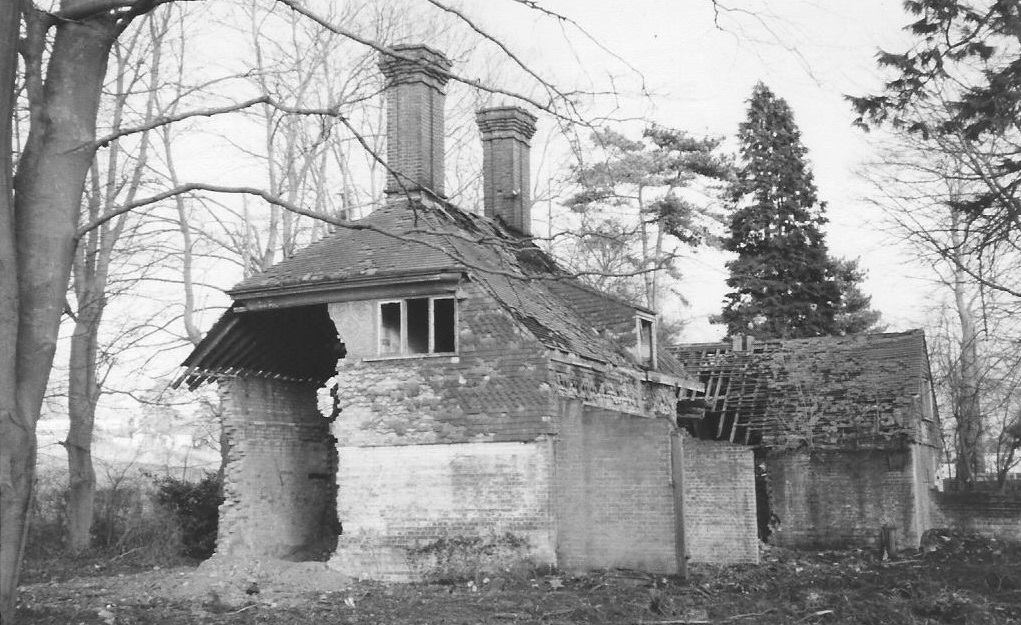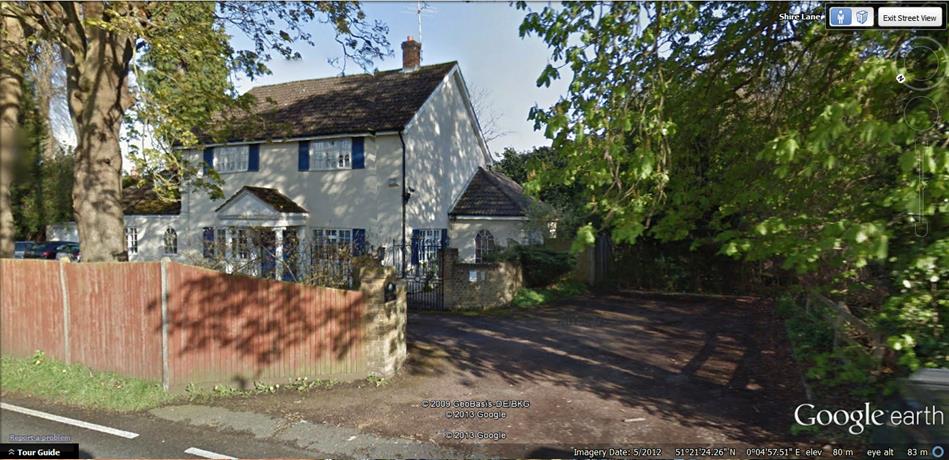


AFTER THE AUCTION
The previous page told of the auction of the Oak Brewery site in 1920, along with the many houses owned by the Fox family in and around Green Street Green. This second page carries the story through to the present day.
Click images and maps to enlarge. Maps copyright Ordnance Survey
Fox’s old Oak Brewery continued to cast its shadow over Green Street Green for years after the July 1920 auction. One memorable Saturday afternoon in 1937, however, traffic was stopped from entering the High Street and locals gathered to gawp from a safe distance as a demolition team brought Fox’s great leaning chimney crashing down, along with much of the building. Later, the site was cleared for sale and redevelopment. But, with the dark clouds of war gathering, nothing more happened.
In 1940, as German bombing raids on London intensified, the Telegraph, Construction and Maintenance Company (Telcon) perched vulnerably at Enderby’s Wharf on the Greenwich Peninsula made a strategic decision to find other premises.
After the war, Frequency Works was used on and off for cable production but it became a poor relation of the busy Greenwich Works. Many of its workers were dispensed with, its canteen shut down and supervision by senior staff resident on the spot was abandoned. At the end of 1952, however, Telcon decided the premises should be rejuvenated to house its newly-created Plastics Division and it remained an industrial site until the mid-1990s, when it was no longer required by Telcon. After strong objections to a big retail development, a neat estate of 52 three- and four-bedroom houses called “The Oaks” was built there instead by Woolwich Homes.

The Poplars, which had the distinction of being the Foxes’ first public house before becoming home to a senior employee, was renamed “Longfield” by its new owner soon after 1920.
When the company began to shift plastics production from Greenwich to Green Street Green, Orpington Urban District Council granted permission for Longfield to be used as offices. This work was finished in August 1953 and by the following February Telcon’s Plastics Division was fully established at Green Street Green. Longfield survived until 1972.
The produce on offer included potatoes, seed oats and barley, parsnip seed, two stacks of rye grass and meadow hay, and four stacks of oat and barley straw.
William and Emily continued to live at Oak Farm and local business directories recorded him there as a farmer up to his death in July 1932 at the age of 70, although he was also a quarryman specialising in chalk and gravel extraction, with a large pit at Green Street Green and others in the area, including at St Paul’s Cray. Emily died a month or two before him, aged 78.
For some years, well into the 1950s, the Botton family, the well-known fairground operators who lived close by from the mid-1930s, stored their rides and machinery at Oak Farm during the off-season. Since then, the site, located opposite Glentrammon Road at the foot of Farnborough Hill, has evolved into a swathe of tarmac and buildings with barely a blade of grass to be seen, though a backdrop of trees provides a screen from the A21 Farnborough Bypass which looks down on it.
In 1983, Oak Farm became the depot for Metrobus, sharing the space with a number of small motor repair works. Metrobus is now part of the London buses operator Go-Ahead whose expansion of the busy garage involved demolishing Oak Cottages, the red-brick and tiled pair at the bottom of Farnborough Hill that once housed brewery employees.
Beechwood, the Fox family home, is long gone, believed to have been demolished around 1939 or 1940. The Beechwood housing estate (Beechwood Avenue, Cleave Avenue, Cocksett Avenue, Ramus Wood Avenue and Kent Close) was built by Coleman Construction in 1935 just across Farnborough Way from the bus garage on part of the grounds that once surrounded the old house.
Its “picturesque” lodge house in Shire Lane, 100 yards from what is now Beechwood Avenue, fell into ruins but has been rebuilt in recent years, see the panel to the right.
In 1925 Arkies also became a tennis centre with three hard courts and advertised the chance to join “The Old Pantile Club” – fully-licensed and offering “social amenities” as an enticement to prospective members. Unfortunately, Arkies’ courts lay roughly where the car park of the present Rose and Crown is today so they were cast adrift from the house when the Farnborough Bypass sliced through two years later – spelling doom for the business.
In the 1930s the Royal Oak pub, which had occupied the neighbouring Round House (The Bombay Indian restaurant since 1984) moved into The Elms
Today it is owned by Vintage Inns and describes itself as “a rustic pub restaurant”.

Robert Partridge was still dispensing teas at Wellhurst, which he continued to do until the early 1930s. The house stayed in Louisa Thompson’s ownership until June 1938, when it passed to Mrs Dora Turner of Sidcup for £1,150. Four days later, Mrs Turner leased it to Frank Luker, also from Sidcup, for seven years with an option to buy.
 |
Luker, a commercial traveller dealing in fur pelts, bought the place for £1,250 as the lease came to an end and sold it in December 1950, after which, it seems, a “canine nursing home” (essentially dog kennels) was established there.
In 1961 Wellhurst changed hands again and by 1973 it was officially recognised as a house of “historic interest”: at the end of June that year it was given the protection of a Grade 2 listing. Historic England describes it as an L-shaped 18th century building of yellow brick and tile hanging with 19th century additions. Among its highlights are a wooden modillion eaves cornice, stuccoed side elevation with a moulded eaves cornice and outside chimney stack built of flint at the bottom and brick at the top.
Yes, Green Street Green is different today. But many elements of the old village can still be found
Patrick Hellicar
THE LOCAL AREA
Beechwood Lodge
These photos show the transformation of the formerly derilict lodge house in Shire Lane to today's house



Beechwood
Alongside the Lodge the former driveway leads uphill to the location of Beechwood itself, now reverted to woodland.The platform where the house once stood can still just be made out.

.jpg)

.jpg)

.jpg)